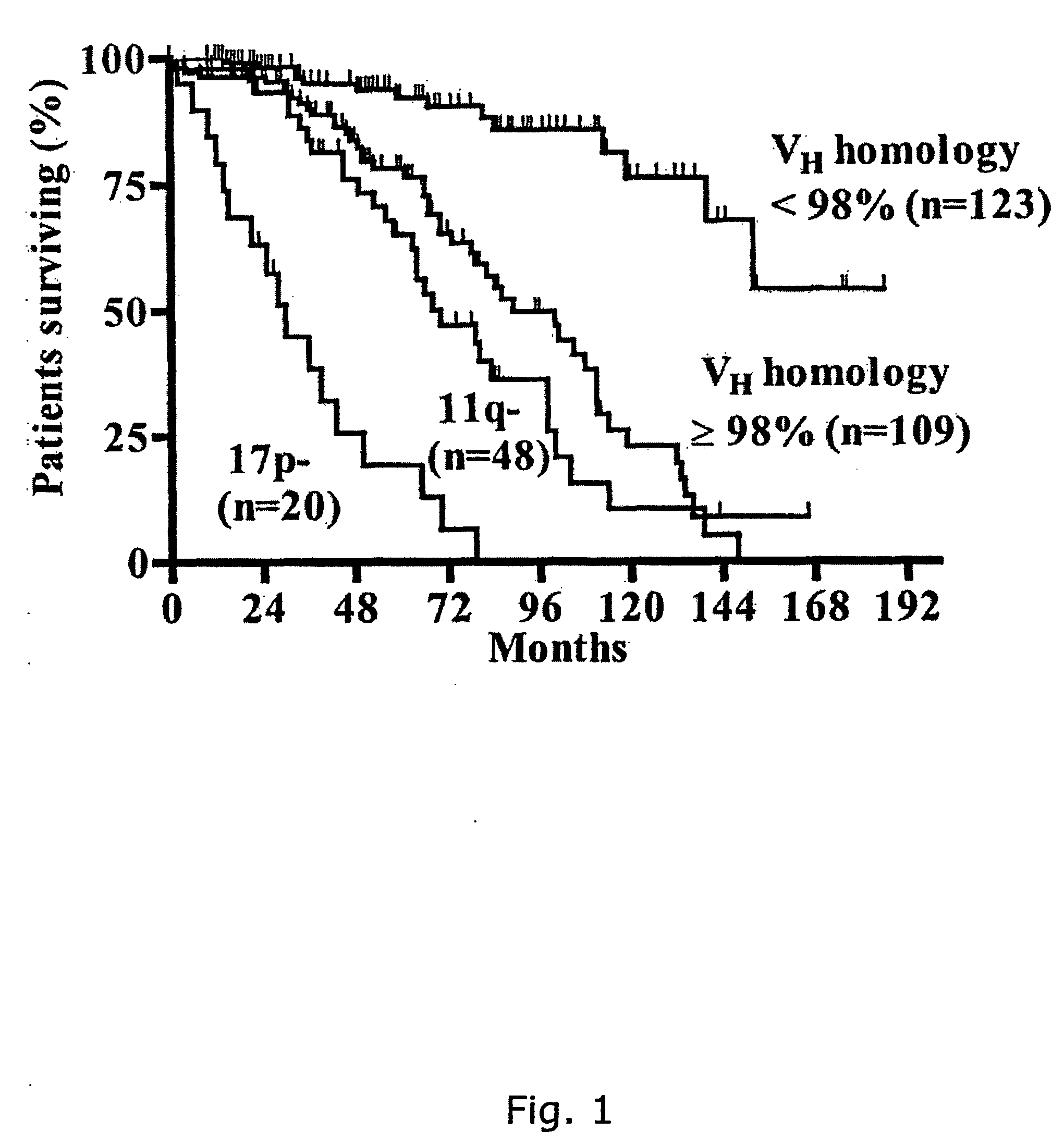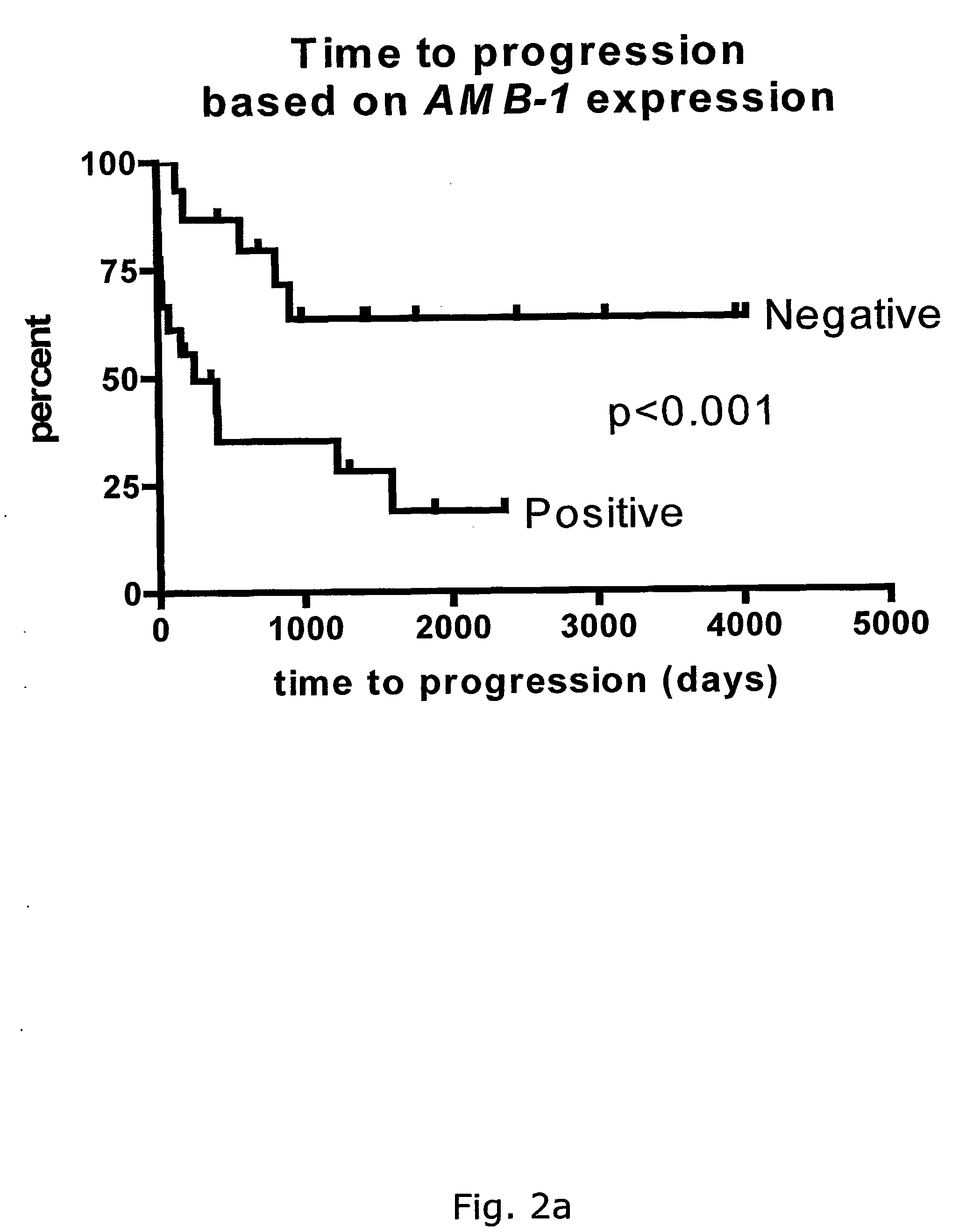Methods and kits for diagnosing and treating b-cell chronic lymphocytic leukemia
a technology for chronic lymphocytic leukemia and kits, which is applied in the field of methods and kits for diagnosing and treating b-cell chronic lymphocytic leukemia, can solve the problems of hampered application of more aggressive treatment strategies, inability to identify reproducible and reliable prognostic predictors, etc., and achieve poor prognosis
- Summary
- Abstract
- Description
- Claims
- Application Information
AI Technical Summary
Benefits of technology
Problems solved by technology
Method used
Image
Examples
example 1
[0230] By Differential Display (Pardee et al., 1992, Jorgensen et al., 1999) part of a gene (hereafter referred to as AMB-1) was found that is expressed in unmutated B-CLL patients with poor prognosis. This gene is not found in the mutated B-CLL patients. When AMB-1 was sequenced and aligned to known sequences in GenBank, perfect homology was found to 225 base pairs (bp) of human genomic DNA from chromosome 12.
[0231] RNA was prepared using the RNeasy kit from Qiagen, as described by the manufactor (Qiagen, Hilden, Germany). RNA was prepared from patients with B-CLL without hyper mutation who, by PCR analysis, using primers FDP5 (CCTTTATGTGTGTGACAAGTG) and F10 (ATCCAGCCAGGATGAAATAGAA), showed a high level of the resulting PCR fragment. Poly-A+ RNA was isolated from total RNA by the “MicroPoly(A)Purist” kit from Ambion, as described by the manufactor (Ambion, Inc., Texas, USA). Cloning-ready cDNA was prepared from 8 μg poly-A+ RNA using the “ZAP Express® XR Library Const...
example 2
Bloinformatic Analysis of AMB-1
[0235] The DNA and protein sequence data bases (GenBank and EBI) have been searched for sequences with similarity to AMB1. There is no significant DNA sequence similarity to any known gene. In particular, the coding region of the AMB1 mRNA (SEQ ID no 3) is not present in any known EST. The only significant match to the complete mRNA sequences and the DNA sequence of the putative coding region were BAC clones derived from the region on human chromosome 12 where the gene is located. The “AMB-1 gene” had not been annotated as a gene on the chromosome. Searches with the peptide sequence in the sptrnr data base of peptide sequences (includes Sprot and nrtrembl) showed a low similarity to putative intron maturases from cloroplasts and to bovine IL4. The percentage similarity to both maturases and bovine IL4 was low (25.6% and 30.3%, respectively) and the similarity to maturases only included a match to 75 amino acids of the much larger maturases. In contras...
example 3
Differential Expression of AMB-1
Patient Material
[0237] Blood samples were collected from newly diagnosed untreated patients with B-CLL. Mononuclear cells were isolated by Lymphoprep separation (Nycomed Pharma, Oslo, Norway), and the percentage of CD5+CD20+ B-CLL cells in the mononuclear fraction was >90% in all samples as determined by flow cytometric analysis.
Isolation of RNA and Conversion to cDNA.
[0238] Material for RNA production was isolated mononuclear cells from B-CLL patients or mononuclear cells from lymphoprep separated buffy coats from normal donors. Total RNA was isolated from 5×107 or more cells using the QIAamp RNA Blood Mini kit (Qiagen, Valencia, Calif.) with DNAse treatment. RNA (1 ug) was converted to cDNA by incubation with a mixture of random-primers (1 μg) and T24-primer (1 μg) for 5 minutes at 70° C. After cooling on ice, the reaction mixture was added to a final volume of 25 μl containing 30U of AMV Reverse Transcriptase HC (Promega, Madison, Wis., USA),...
PUM
| Property | Measurement | Unit |
|---|---|---|
| Fraction | aaaaa | aaaaa |
| Fraction | aaaaa | aaaaa |
| Fraction | aaaaa | aaaaa |
Abstract
Description
Claims
Application Information
 Login to View More
Login to View More - R&D
- Intellectual Property
- Life Sciences
- Materials
- Tech Scout
- Unparalleled Data Quality
- Higher Quality Content
- 60% Fewer Hallucinations
Browse by: Latest US Patents, China's latest patents, Technical Efficacy Thesaurus, Application Domain, Technology Topic, Popular Technical Reports.
© 2025 PatSnap. All rights reserved.Legal|Privacy policy|Modern Slavery Act Transparency Statement|Sitemap|About US| Contact US: help@patsnap.com



